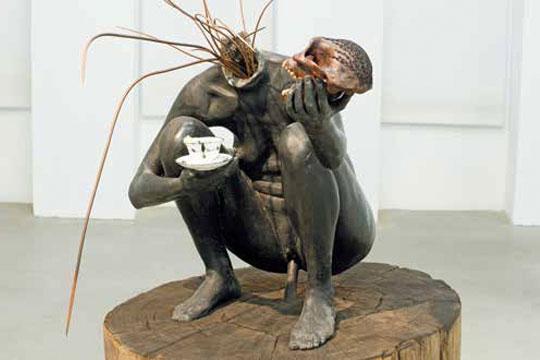BHARTI KHER: MISDEMEANOURS
| May 28, 2014 | Post In LEAP 26

Fiberglass, porcelain, plastic, mahogany, copper wire, 180 x 180 x 100 cm
Courtesy of the artist and Galerie Perrotin
Bharti Kher’s first solo exhibition in China brings together her most representative works. The perplexing title of this exhibition is shared by an installation at the entrance, that of a hyena (more precisely, its buttocks). The hyena stands on a trolley, atop a pile of wooden planks, its body draped in animal hide, and with its head turned, greets visitors with an extremely untrusting expression. Another piece, titled Virus V, located on a wall not far away, emits dizzying sparkles of light, adding to the discomfort. Indeed, if this exhibition were instead titled “Misconduct,” its wild charm would be much more readily apparent, and a disturbing presence within the nowadays excessively neat building of the Rockbund.
Visitors are naturally drawn to this female Indian artist’s use of the bindi as a primary material, like the meticulously detailed bindi “painting” which flows out from within a shiny, reflective stainless steel frame, appearing simultaneously like dazzling fireworks and colorful flowers. No matter the ambiguity of the title—What can I tell you that you don’t know already?—visitors make a cheerful beeline to this work, even ignoring the piece behind them: a golden bowl inscribed with Hindi script and filled with grain, a simple offering of human sustenance lost in a throng of people with their heads bowed, scrutinizing the exhibition pamphlet.
Identity, gender, and hybridity are themes Kher grapples with in her work. In the 1990s she decided to leave Britain, where she was born and raised, and move to India, the country her parents had left behind. She was both returning and going to India, the West being both home and the Other. Or perhaps both were in fact the Other, and furthermore, male. The 1990s was a period of economic opening and liberalization in India, part of a gradual move towards post-colonial globalization, and also towards the world Kher had chosen to leave. She attempted to adopt the meticulous and confusing traditions of Indian femininity (such as the bindi), though ultimately felt out of place and restless. She possessed the power of the relatively uninhibited Western woman (the sharp-witted female, as if imbued with male characteristics), though also had to prevent this from becoming a tool of ridicule towards other Indian women. To help with this, Kher turned to the Gods, specifically, to the headless goddess Chinnamasta. And the while the benevolent slept depicts this goddess of sexual energy and self-sacrifice, though in this instance, it is not her own head she holds in her hand, but that of an ape. This act of modification perhaps refers to encounters between colonizers and the colonized, both in previous centuries and today. On the fifth floor a series of East India Company maps emblazoned with bindis can be found, one of which features the caption “the Western route to China.” Despite Kher’s interest in archaeological forms, these are actually intended as a response to the vestige of British imperialism in which this exhibition is housed (the former Royal Asiatic Society). Using these maps, the British moved to China after establishing themselves in the islands of East India.
In both Kher’s most famous piece, The skin speaks a language not its own, a female elephant skin covered in hundreds of bindis that resemble sperm, and Bloodline, a giant pillar made of red bangles which stretches through three floors, ordinary Indian objects are, through intensive labor combined with highly developed techniques, turned into awe-inspiring and thrilling works of “contemporary art.” Chinese audiences are often frustrated by a lack of information about India, and Kher may not necessarily be considered an “Indian artist” by the native Indian art world. Her anxiety is seen as too haughty, too “global.” One might suspect that using Indian characteristics as she does—with such directness and intensity to the extent that native artists find distasteful— is to wander to that other side of the world. But do Chinese audiences now count as standing on that other side?

